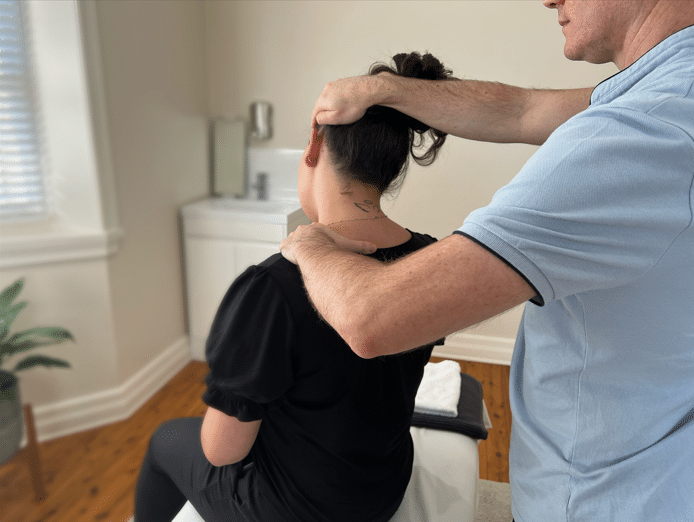- 02 9712 1736
- [email protected]
- 212 Great North Road, Five Dock, NSW 2046
- Open 6 days from 7am
Chronic pain can be a major source of unhappiness in your daily life, affecting your ability to complete simple tasks, resulting in a reduced quality of life. Millions of people around the world battle with chronic pain every day with roughly 1 in every 5 adults having had experienced some level of chronic pain in their lifetime.

Chronic pain is defined as persistent pain anywhere on the body that lasts for more than three to six months. Out of these, back pain is the most common type of chronic pain, with a study in 2017 ranking low back pain as the leading cause of disability worldwide. When left untreated for an extended period of time, chronic pain often becomes a complex condition that requires a multifaceted approach for effective management. While traditional medical interventions play a crucial role, an increasing number of individuals are turning to chiropractic care to find relief. In this blog post, we will explore the benefits of chiropractic care for chronic back pain, understanding the nature of chronic pain, how it develops, and various strategies for managing it.
Chronic pain is a complex condition that can significantly impact your physical, emotional, and mental well-being. Chronic pain persists long after the initial injury due to changes to the central nervous system resulting in the persistence of pain signals. Additionally, psychological factors like stress, anxiety, and depression can amplify the perception of pain, creating a complex interplay between physical and emotional elements. It can manifest in various forms, such as headaches, back pain, arthritis, or neuropathic pain, making daily activities challenging and diminishing overall quality of life.
Let’s take a look at a common example of how lower back pain develops into chronic pain.
One common cause of lower back pain is herniated or ruptured disks. Disc herniation often stems from a combination of factors, with the mechanism of injury typically involving wear and tear on the spinal discs over time. The intervertebral discs, acting as shock absorbers between the spinal vertebrae, can degenerate due to aging or repetitive stress. As these discs weaken, the inner core, known as the nucleus pulposus, may bulge or rupture through the tough outer layer, called the annulus fibrosus.

Several contributing factors include:
With aging, spinal discs naturally lose water content and elasticity, making them more prone to herniation.

Engaging in activities that involve repetitive bending, lifting, or twisting can accelerate disc degeneration and increase the risk of herniation.
Lifting heavy objects with improper form, especially with a rounded back, can place excessive pressure on the spinal discs and contribute to herniation.

While less common, a sudden and forceful impact, such as a fall or car accident, can also cause herniation.
Some individuals may be genetically predisposed to disc degeneration, making them more susceptible to herniation and back problems.
When a disc herniates, the displaced material may result in nerve compression, leading to severe pain, numbness, and weakness. In response to the irritation, the body’s natural reaction is to protect itself, leading to spasms of the muscles. These spasms serve as a protective mechanism, attempting to stabilize the spine and prevent further injury, which if left unaddressed, will lead to a cycle of inflammation, muscle imbalances, and detrimental structural changes.
Treatment options including physical therapy or chiropractic care aim to alleviate both the disc-related issues and the associated muscle spasms. A physical examination and in some cases, medical imaging such as bone scan or x rays, may be necessary to correctly identify the source of ailments so that the appropriate treatment can be provided.
Chronic pain develops from acute pain when it is left untreated or are inadequately addressed. It is possible for acute lower back pain and other symptoms to appear to resolve itself following a few weeks of rest. However, when left untreated, this is achieved by altering posture or movement patterns to compensate for the loss of movement in the painful range. The natural attempt of the body to avoid discomfort, may inadvertently contribute to the development of chronic lower back pain.
Untreated acute back pain can lead to a cycle of inflammation, muscle imbalances, and structural changes in the spine. Over time, these changes can result in persistent pain, as the body adapts to the ongoing stress on the musculoskeletal system. In the central nervous system, your body reduces your pain threshold and increases pain signals to increase your awareness of the injury. Additionally, untreated acute back pain may contribute to psychological factors such as stress and anxiety, further exacerbating the perception of pain.
It underscores the importance of getting pain diagnosed early and receiving back pain treatments early to prevent its progression into a chronic and potentially more challenging condition to treat.

Appropriate management requires a comprehensive approach that addresses both the physical and psychological aspects of the condition. Common strategies include medication, physical therapy, lifestyle modifications, and, increasingly, complementary therapies like chiropractic care.

Chiropractic care focuses on the musculoskeletal system, employing non-invasive techniques such as soft tissue work to address muscle spasms, and spinal adjustments to alleviate pain and modulate the central nervous system. Unlike some medical interventions that involve surgery or medication, chiropractic care aims to promote natural healing and restore proper function without the need for invasive procedures.

Chiropractors believe in addressing the root cause of pain rather than merely treating symptoms. By focusing on the musculoskeletal and nervous system, chiropractic adjustments aim to improve joint mobility and retrain compensatory movement patterns. This holistic approach seeks to enhance the body’s ability to heal itself.

Chronic pain often restricts movement and hinders daily activities. Chiropractic adjustments can help improve joint mobility, reduce muscle tension, and enhance overall function. This can lead to increased flexibility and a greater range of motion, contributing to a better quality of life.

Chiropractic care can be seamlessly integrated into a multidisciplinary approach to chronic pain management. It can complement other treatments such as physical therapy, medication, and lifestyle modifications, providing a well-rounded strategy for addressing the various dimensions of chronic pain.
Each individual’s experience of chronic pain is unique, requiring personalized treatment plans. Chiropractors assess patients thoroughly to understand the specific nature of their symptoms and tailor their treatment approach accordingly. This individualized approach enhances the effectiveness of chiropractic care in addressing the unique needs of their patients.
For individuals seeking alternatives to long-term medication use, chiropractic care may offer a viable option. By addressing the underlying issues contributing to pain, chiropractic adjustments may contribute to a reduction in the need for certain pain medications, minimizing the potential for side effects and dependency.

Chiropractic care has emerged as a valuable and holistic approach to managing chronic pain, offering individuals an alternative or complementary option to traditional medical interventions. By focusing on improving and maintaining the mobility of the spine and retraining the nervous system, chiropractic adjustments aim to address the root cause of pain, promote natural healing, and enhance overall well-being. As part of a comprehensive management plan, chiropractic care can empower individuals to regain control over their lives, fostering a sense of relief and improved quality of life. Always consult with healthcare professionals to develop a personalized treatment plan that best suits your unique needs and circumstances.

Forest Lodge, Annandale, Glebe, Leichhardt, Balmain, Haberfield, Canada Bay, Rozelle, Rodd Point, Wareemba, Stanmore, Petersham, Lilyfield, Hunters Hill, Enfield, Cabarita, Mortlake, Rhodes, Burwood Heights, Birchgrove, Gladesville, Huntleys Point, Abbotsford, Ashfield, Croydon Park, Croydon, Chiswick, Russell Lea, Burwood, Strathfield, Concord, Drummoyne, North Strathfield, Liberty Grove, Dulwich Hill, Lewisham, Camperdown, Ashbury, Homebush, Homebush West, Woolwich, Henley, Summer Hill, Sydney Olympic Park
About
Five Dock Osteopathic & Chiropractic is located in Canada Bay, in Sydney’s Inner West. Servicing suburbs including Burwood, Croydon, Drummoyne, Five Dock, Haberfield, Concord, Abbotsford, Chiswick, Leichhardt, Wareemba, Russell Lea, Summer Hill, Strathfield.
Clinic hours
Monday, Tuesday, Thursday 7AM – 7PM
Wednesday, Friday 7AM – 5PM
Saturday 7AM – 2PM
Sunday Closed
Contact details
212 Great North Road, Five Dock, NSW 2046
Phone: 02 9712 1736
Fax : 02 9712 1736
Email : [email protected]